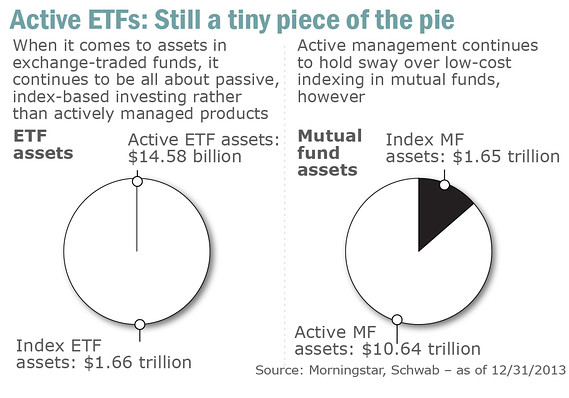Active ETFs: Dominating Index Funds in 2025 Market

Active ETFs are steadily transforming the investment landscape, capturing the attention of retail investors and redefining ETF market trends. Unlike traditional index funds that follow a passive investment strategy, actively managed ETFs aim to outperform the market by making strategic asset allocations based on real-time analysis. In recent months, there has been a notable increase in assets flowing into these innovative ETFs, highlighting a significant shift in investment strategies among investors who seek both growth and income. This shift is particularly pronounced among younger retail investors who are increasingly looking for diversified and active management options that provide tax efficiency and liquidity. As market volatility continues to drive trading activity, the rise of active ETFs signals a pivotal moment for the future of investment vehicles.
Actively managed exchange-traded funds, often referred to as “active ETFs,” represent a dynamic approach to asset management that stands in contrast to standard index funds. These investment vehicles are gaining popularity due to their ability to adapt quickly to market changes, making them appealing to those navigating the uncertainties of today’s financial landscape. The growing interest from retail investors reflects a broader trend as individuals seek more sophisticated investment strategies that can potentially outperform static benchmarks. Furthermore, the evolving landscape of the ETF market suggests that active management will play a crucial role in shaping future investment opportunities as it challenges the long-standing dominance of passive investment approaches.
The Shift Towards Active ETFs
The exchange-traded fund industry is witnessing a remarkable transition with the increasing popularity of actively managed ETFs. Following a decade where index funds held a dominant position, recent metrics indicate a significant uptick in assets flowing into active equity ETFs. This represents not just a trend, but a paradigm shift as younger retail investors, who are inherently more risk-tolerant, are increasingly drawn to dynamic investment strategies that active management offers. As investors seek more personalized portfolio strategies amidst market volatility, the inflows into these funds highlight a growing appetite for more active approaches in an otherwise passive landscape.
Investment experts have noted this radical shift in ETF flows, with actively managed ETFs capturing a larger share of the investor base than previously anticipated. Predicted inflow stats reflect a rebalancing of investment attitudes—suggesting that retail investors are more willing to embrace risk and explore opportunities beyond traditional index funds. Such changes point towards a long-term reevaluation of strategies, as many now prioritize the unique insights and adaptive strategies that active fund managers can provide in uncertain market climates.
Frequently Asked Questions
What are actively managed ETFs and how do they differ from index funds?
Actively managed ETFs, or active ETFs, are investment funds that actively select and manage a diversified portfolio of securities, unlike index funds that passively track a specific market index. The key difference lies in management strategy: active ETFs aim for investment returns that outperform benchmarks by using various research and analysis techniques to select stocks based on market trends, whereas index funds seek to mirror the performance of an index.
Why are actively managed ETFs gaining popularity among retail investors?
The rise of actively managed ETFs among retail investors can be attributed to several factors including recent market volatility, the emergence of new and innovative active ETFs, and changing preferences among younger investors. These funds offer flexible investment strategies that can adapt to market conditions, making them appealing for retail investors looking for dynamic management and potential outperformance over traditional index funds.
How are active ETFs impacting the ETF market trends in 2025?
In 2025, active ETFs are significantly impacting ETF market trends by attracting a considerable share of investor flows, surpassing traditional index funds in net inflows during periods of market volatility. As more active ETFs enter the market and gain traction with retail investors, the landscape is shifting, suggesting that the dominance of index funds may face new challenges from effective active management strategies.
What unique investment strategies do actively managed ETFs employ?
Actively managed ETFs employ various investment strategies ranging from ‘bottom-up’ stock selection to quantitative models that enhance performance while staying close to index benchmarks. These strategies often include tactical asset allocation that responds to market conditions, investment in niche sectors, and a focus on income generation or downside protection, which position active ETFs favorably against index funds in uncertain markets.
How do the expense ratios of active ETFs compare to index funds?
Generally, actively managed ETFs tend to have slightly higher expense ratios compared to index funds due to the active management involved. However, they still offer competitive fees relative to traditional mutual funds, and many ETFs feature low expense ratios overall. For investors, the potential for higher returns through active management may justify the higher costs, especially in volatile market environments.
What factors should investors consider when choosing between active ETFs and index funds?
When choosing between active ETFs and index funds, investors should consider factors such as risk tolerance, investment objectives, market conditions, and the specific strategies employed by the fund. Additionally, evaluating historical performance, fees, and tax efficiency can help investors determine which option aligns best with their financial goals and investment strategy.
Are actively managed ETFs suitable for long-term investment strategies?
Yes, actively managed ETFs can be suitable for long-term investment strategies, particularly if they focus on generating alpha by outperforming benchmarks over time. Investors need to assess the manager’s track record, the fund’s investment approach, and how it aligns with their long-term goals. With ongoing market changes, active strategies can provide opportunities for growth and capital preservation in a diversified portfolio.
What role do active ETFs play in diversifying an investment portfolio?
Active ETFs play a vital role in diversifying investment portfolios by providing exposure to various asset classes and sectors with the potential for superior returns. By actively adjusting their holdings based on market conditions, they can mitigate risks associated with market downturns and complement more stable index funds, enhancing overall portfolio performance.
| Key Points |
|---|
| Active ETFs are experiencing significant inflows, indicating a shift from index funds. |
| The rise in retail investors and market volatility is driving this transition. |
| Active ETFs now account for over one-third of investor flows in 2025, despite holding only 10% of market assets. |
| The ETF market is expected to see continued innovation with new active funds being launched. |
| Investors are advised to remain calm during market fluctuations and focus on long-term strategies. |
Summary
Active ETFs are rapidly changing the landscape of investment in 2025, as evidence shows a growing preference among investors for actively managed funds over traditional index funds. With a remarkable shift in inflows being directed towards active equity ETFs, it’s clear that this trend is not just a passing phase but a significant movement influenced by younger investors and market dynamics. As the market continues to evolve, the standout performance of Active ETFs highlights the importance of adaptability in investment strategies.




